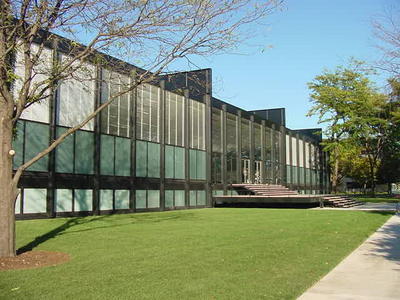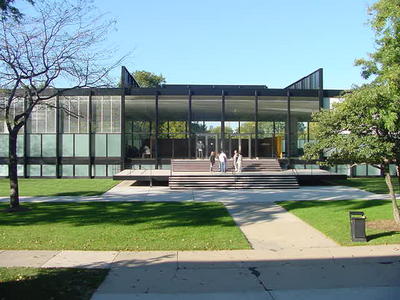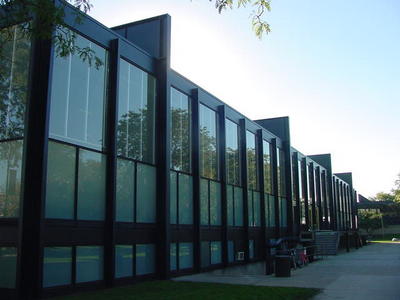So here's another try, on the brevity tip. Today I traveled via the El to see some of one of the most famous collections of architecture in one of American architecture's capitals, Chicago. The Illinois Institute of Technology, located at State Street and E. 35th, just across the Dan Ryan Expressway from the Chicago White Sox's Cellular One (New Comiskey) ballpark, was the US homebase for one of 20th century's greatest architects, Ludwig Mies van der Rohe (1886-1969). A emigré from Germany, where he'd pioneered an original avant-garde "functionalism" that synthesized elements of the deStijl school, the unornamented façades of Austrian Secessionism, and Frank Lloyd Wright's Prairie Style to novel effect, and led the Bauhaus School in its final days before the Nazi takeover of the government, Mies assumed the leadership of the architecture school at what was then the Armour Institute of Technology. He devised a new, comprehensive masterplan for the campus, designed many of its buildings, and went on to develop the highly influential International Style, whose apotheoses are his Farnsworth House (1946), 860-880 Lake Shore Drive apartments (1948), the Seagrams Building in New York (1954-1958), Neue Nationalgalarie in Berlin (1965-1968), the Illinois Center in Chicago (1967). It is perhaps true to say that a Miesian vocabulary, however, has defined much skyscraper building from the late 1940s on, with architects all across the world drawing upon his various exposed truss, "glass boxes." (He was among the first architects to propose the glass skyscraper, as far back as 1919).
One of his true masterpieces is Crown Hall, which was built from 1950-1955/56, after Mies had designed a number of important campus buildings, such as Alumni Memorial, Perlstein and Wishnick Halls, and established his signature style. Crown Hall underwent a complete external and internal renovation over the last few years, and supposedly looks even more beautiful today than it did when it first opened. As the Chicago Landmarks website says
A defining structure of 20th-century modern architecture, this is one of the masterpieces of the world-reknowned architect Ludwig Mies van der Rohe. Designed to house Illinois Institute of Technology's departments of architecture, planning, and design, the building's dramatic, structurally-expressive form resulted from the need to create an open interior space that could be flexibly adapted for changing needs and uses. Instead of interior columns, the roof is hung from exposed steel trusses bridging the depth of the building. It was named for S. R. Crown, a co-founder of the Material Service Corporation.
Here are some of my photos:

Crown Hall, from the front, southwest corner

Crown Hall, frontal view, facing the main entryway

Crown Hall, rear view (from State Street side)

Interior shot of Crown Hall (Not being affiliated with IIT in any way, I was prohibited from setting foot in this building, though I did wander through the Rem Koolhaas-designed McCormick Tribune Campus Center, which I'll post photos of tomorrow--so I had to photograph it through the front door's panes, thus the reflections of the trees hovering, like phantasms of Mies, atop the shadowed interior).

A similar building in the Miesian style is Hermann Hall, the student union building, which Walter Netzsch of Skidmore, Owings and Merrill designed in 1962. It strongly resembles Crown Hall, yet it lacks the earlier building's purity of line, formal symmetry, and innovative internal structure. From a distance, though, it would hard to tell them apart.
One of the first things I thought after seeing these and the other Mies buildings up close was, even though they're 50 years old, they don't look dated and they still look modern. In fact, they look as contemporaneous as the Koolhaas and Jahn buildings across State Street. I wish Mies had laid the buildings out so that instead of turning outwards from each other--they cluster around the walkways that are are extensions of the surrounding streets (Dearborn, etc.)--they formed an inwards-turning axis so that from the front of one you could see the entrances to the others. From the rear of Crown Hall you can see some of the older buildings, but it faces a dreary building that might have been a Mies toss off, or something built in the Mies style that doesn't make the grade.









No comments:
Post a Comment